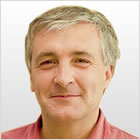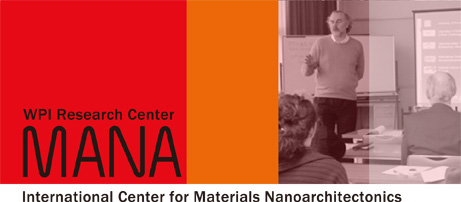Christian Joachim

- Affiliation:
- Nanosciences Group, Center for Material Elaboration & Structural Studies (CEMES), CNRS, France
- Specialty:
- Computer Science and Nanoscience
- Academic degree:
- PhD in Applied Mathematic (1985) and PhD in Quantum Physics
Education & Research History
Molecular Electronics started on my home blackboard one evening in May 1979. At that time, I was studying solid state physics of electronics in a French "grande école", named "Ecole Superieure d'Ingénieurs en Electronique and Electrotechnique" (ESIEE) in Paris. During that period, I was also studying at the Masters level "Quantum Field Theory and Laser" at the University of Paris VI (Jussieu). After graduating from ESIEE and getting in the same year his Masters from the Paris VI University, I decided to spend at least a year far away from France. I was attached to the French embassy in Singapore, teaching at the Singapore Polytechnic during the year 1980-1981. This was a fantastic experience; first because I discovered Asia and Singapore, and second because during this period, I started to work on Molecular Electronics, a not very well known field at that time.
When returning to France in 1982, Elf-Aquitaine recruited me to survey the potential of Molecular Electronics. After a year with Elf-Aquitaine, I became Assistant Professor in applied mathematics at the "grande école" "Ecole Nationale de l'Aeronautique et de l'Espace (Sup'Aero)" in Toulouse. In parallel, I prepare a PhD on the mathematical physics behind the concept of Molecular Electronics. In 1985, it was the first PhD thesis in Europe on Molecular Electronics at the nanoscale. The success of my PhD thesis was the occasion to contact J.P. Launay, just nominated Professor of Chemistry at Paris VI University and A. Aviram from IBM T.J. Watson Research Center near New York. After my PhD and for the year 1985-86, I was recruited Assistant Professor at the University Paul Sabatier (Toulouse) in the CNRS Laboratoire de Physique Quantique. Here, I worked on the technique to calculate the tunnelling current intensity through a single molecule interconnect between 2 electrodes.
At the end of 1986, I went to work as a post-doc with Dr. A. Aviram at IBM T.J. Watson Research Center. There, I quit the theory of Molecular Electronics and had fun with scanning tunnelling microscope (STM) experiments on single molecules. In 1987, with A. Aviram and M. Pomerantz, we succeeded for the first time using an STM for switching ON and OFF a single hemiquinone molecular switch. In parallel, I develops the first molecular orbital theory of tunnelling current through a molecule which gives rise later in 1990 to the Elastic Scattering Quantum Chemistry (ESQC) calculation technique, now a standard technique in calculating and interpreting STM images of molecules adsorbed on a surface.
When returning to France by the end of 1987, I was recruited by CNRS in the Prof. J.P. Launay group in Paris as a permanent CNRS researcher. There, I gave the first complete demonstration of the exponential behaviour of electron transfer process through a molecule as a function of its length, generalising to its exact expression the perturbative approach given in 1964 by Prof. McConnell. This was followed by a large number of theoretical studies and design of molecular wires and molecular switches.
In 1990, I spent a sabbatical in IBM Zurich labs working on the tunnelling effect through a single molecule with Prof. H. Rohrer and Dr. G. Travaglini. At this occasion, I started to work with J.K. Gimzewski on the understanding of STM images. The very positive outcome of this collaboration was the first ever measurement of the electronic resistance of a single molecule. As early as in 1994, the C60 resistance at electronic contact was measured to be 55 M
My collaboration with J.K. Gimzewski opened a new era for Molecular Science. First, in 1996, we learnt how to manipulate a large molecule at room temperature using the tip of a STM. Second, as early as in 1997, we learnt how to change the electronic structure of a single molecule by acting on its conformation or on its geometry. This was the conclusion of my work started with A. Aviram 10 years before, a proof that molecular devices, at a single molecule basis, can really work. Single molecular machines follows with the discovery of the first molecular rotor (1.2 nm in diameter) in 1998. In 2001 and 2003, the first prototype of mono-molecular robots came from those pioneering experiments. The first single molecular amplifier started in 1997, the design of hybrid molecular circuit with more than 1000 single C60 molecular transistors in 2000, the first intramolecular switch in 2001 in collaboration with Dr. F. Moresco and Dr. G. Meyer from F.U. Berlin, and the first mono-molecular circuit in 2003 resulted all from those pioneering results on a single C60 molecule. In fact, I have invented the first single molecule amplifier in the summer of 1996 during my sabbatical at RIKEN (Japan). At that time, I was working with Prof. M. Aono on interpreting STM images of atomic manipulation on the Si(100) surface.
In parallel, the manipulation of a single molecule on a metallic surface opened the way to contact a single molecular wire as early as in 1999, also in collaboration with Dr. J.K. Gimzewski. This was continued in collaboration with F. Moresco in Berlin in 2003 by STM imaging for the first time, and studies of the surface electronic states of the pad as a result of the electronic interaction between a molecular wire end and its metallic pad. This is considered as the real starting point of mono-molecular electronics and atomic scale technology as announced in my seminal year 2000 Nature review paper.


